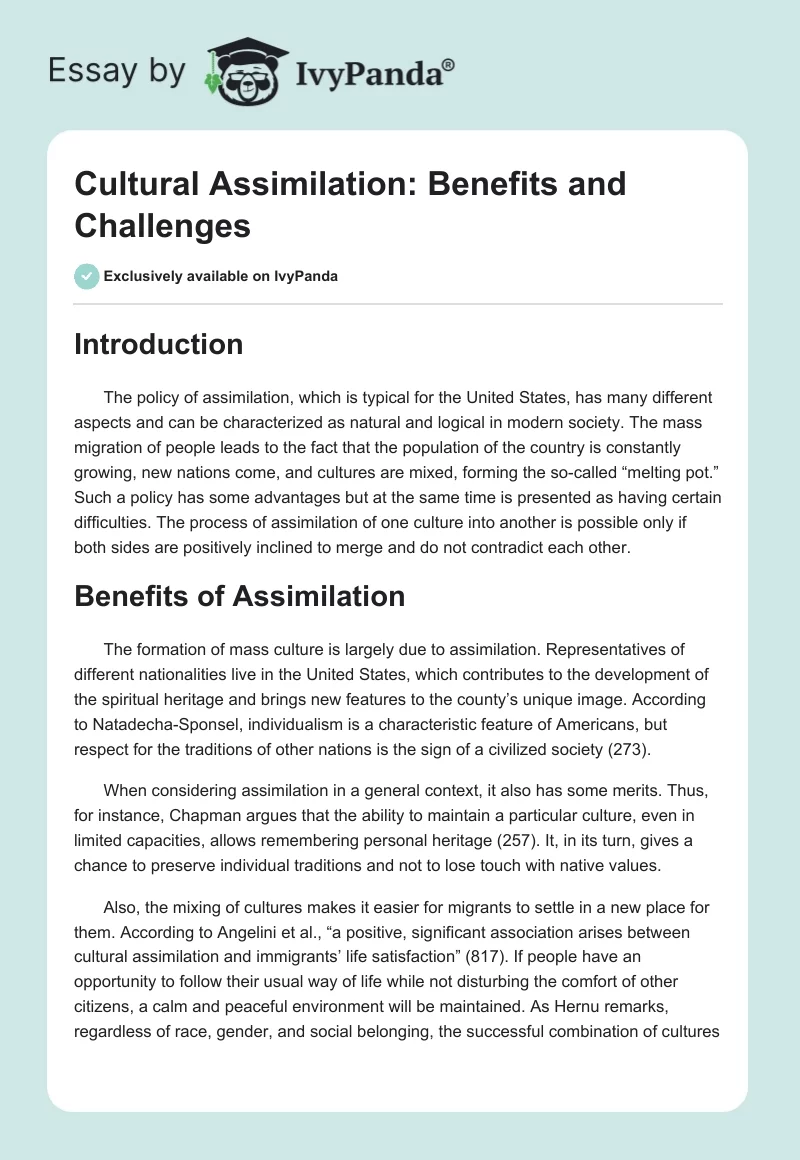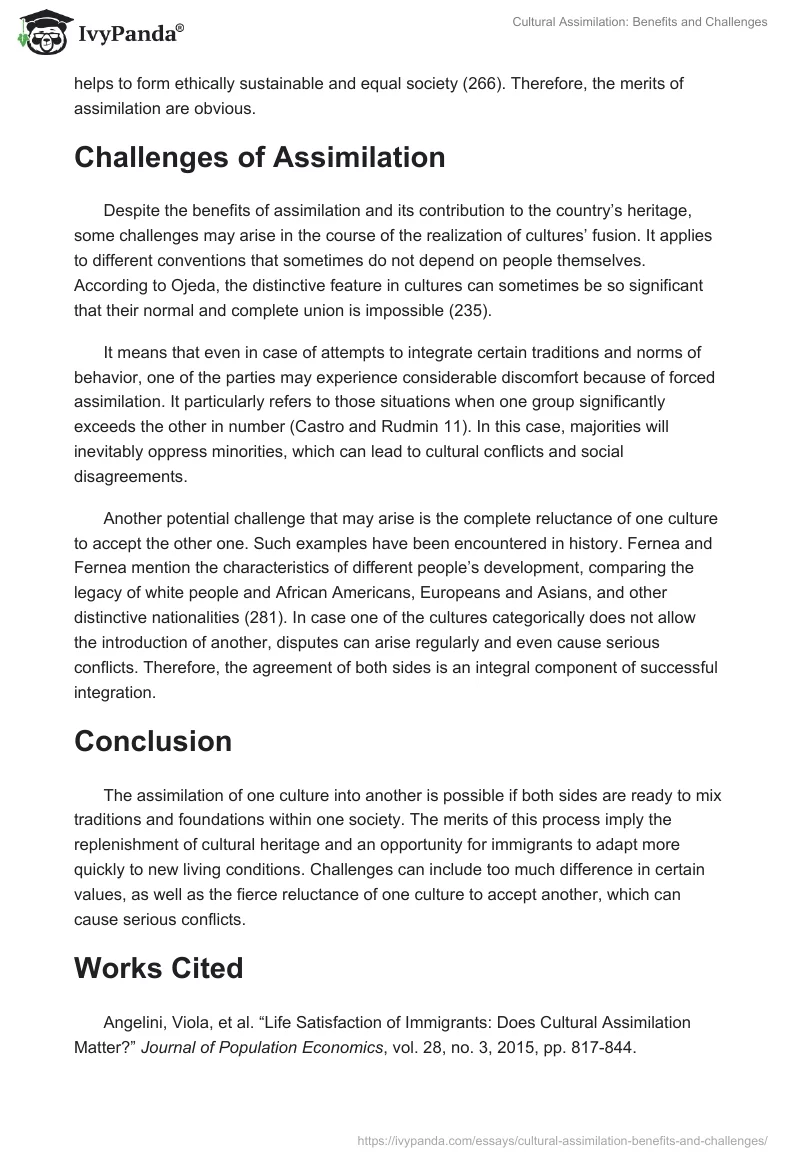Introduction
The policy of assimilation, which is typical for the United States, has many different aspects and can be characterized as natural and logical in modern society. The mass migration of people leads to the fact that the population of the country is constantly growing, new nations come, and cultures are mixed, forming the so-called “melting pot.” Such a policy has some advantages but at the same time is presented as having certain difficulties. The process of assimilation of one culture into another is possible only if both sides are positively inclined to merge and do not contradict each other.
Benefits of Assimilation
The formation of mass culture is largely due to assimilation. Representatives of different nationalities live in the United States, which contributes to the development of the spiritual heritage and brings new features to the county’s unique image. According to Natadecha-Sponsel, individualism is a characteristic feature of Americans, but respect for the traditions of other nations is the sign of a civilized society (273).
When considering assimilation in a general context, it also has some merits. Thus, for instance, Chapman argues that the ability to maintain a particular culture, even in limited capacities, allows remembering personal heritage (257). It, in its turn, gives a chance to preserve individual traditions and not to lose touch with native values.
Also, the mixing of cultures makes it easier for migrants to settle in a new place for them. According to Angelini et al., “a positive, significant association arises between cultural assimilation and immigrants’ life satisfaction” (817). If people have an opportunity to follow their usual way of life while not disturbing the comfort of other citizens, a calm and peaceful environment will be maintained. As Hernu remarks, regardless of race, gender, and social belonging, the successful combination of cultures helps to form ethically sustainable and equal society (266). Therefore, the merits of assimilation are obvious.
Challenges of Assimilation
Despite the benefits of assimilation and its contribution to the country’s heritage, some challenges may arise in the course of the realization of cultures’ fusion. It applies to different conventions that sometimes do not depend on people themselves. According to Ojeda, the distinctive feature in cultures can sometimes be so significant that their normal and complete union is impossible (235).
It means that even in case of attempts to integrate certain traditions and norms of behavior, one of the parties may experience considerable discomfort because of forced assimilation. It particularly refers to those situations when one group significantly exceeds the other in number (Castro and Rudmin 11). In this case, majorities will inevitably oppress minorities, which can lead to cultural conflicts and social disagreements.
Another potential challenge that may arise is the complete reluctance of one culture to accept the other one. Such examples have been encountered in history. Fernea and Fernea mention the characteristics of different people’s development, comparing the legacy of white people and African Americans, Europeans and Asians, and other distinctive nationalities (281). In case one of the cultures categorically does not allow the introduction of another, disputes can arise regularly and even cause serious conflicts. Therefore, the agreement of both sides is an integral component of successful integration.
Conclusion
The assimilation of one culture into another is possible if both sides are ready to mix traditions and foundations within one society. The merits of this process imply the replenishment of cultural heritage and an opportunity for immigrants to adapt more quickly to new living conditions. Challenges can include too much difference in certain values, as well as the fierce reluctance of one culture to accept another, which can cause serious conflicts.
Works Cited
Angelini, Viola, et al. “Life Satisfaction of Immigrants: Does Cultural Assimilation Matter?” Journal of Population Economics, vol. 28, no. 3, 2015, pp. 817-844.
Castro, Joaquim, and Floyd W. Rudmin. “Acculturation, Acculturative Change, and Assimilation: A Research Bibliography with URL Links.” Online Readings in Psychology and Culture, vol. 8, no. 1, 2017, pp. 9-15.
Chapman, Stephen. “The Prisoner’s Dilemma.” One World, Many Cultures, edited by Stuart Hirschberg and Terry Hirschberg, 10th ed., Pearson, 2017, pp. 256-263.
Fernea, Elizabeth W., and Robert A. Fernea. “A Look Behind the Veil.” One World, Many Cultures, edited by Stuart Hirschberg and Terry Hirschberg, 10th ed., Pearson, 2017, pp. 280-287.
Hernu, Piers. “Norway’s Ideal Prison.” One World, Many Cultures, edited by Stuart Hirschberg and Terry Hirschberg, 10th ed., Pearson, 2017, pp. 264-271.
Natadecha-Sponsel, Poranee. “Individualism as American Cultural Value.” One World, Many Cultures, edited by Stuart Hirschberg and Terry Hirschberg, 10th ed., Pearson, 2017, pp. 272-279.
Ojeda, Amparo B. “Growing up American: Doing the Right Thing.” One World, Many Cultures, edited by Stuart Hirschberg and Terry Hirschberg, 10th ed., Pearson, 2017, pp. 234-239.


